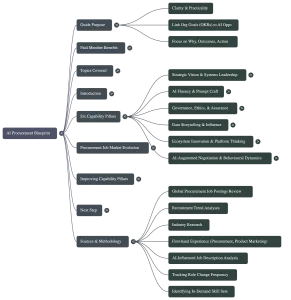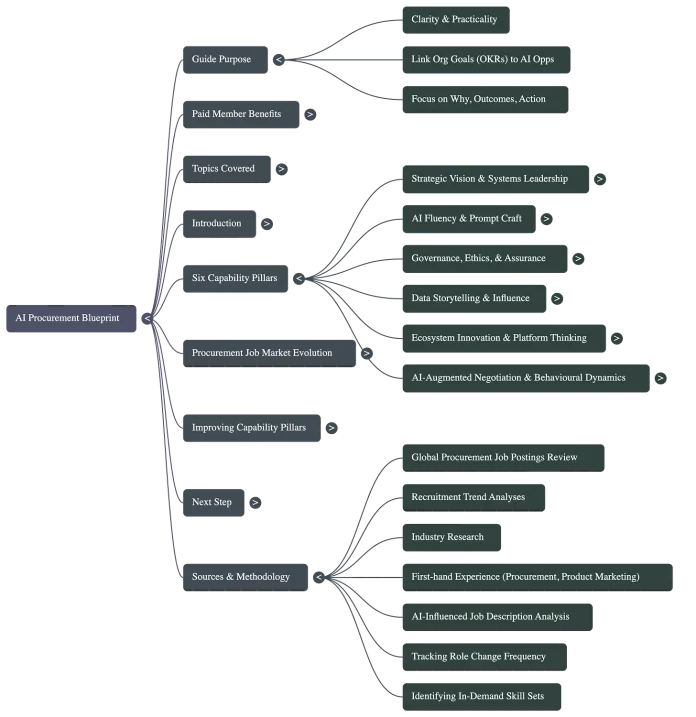6 AI Procurement Capability Pillars You Need
The AI Procurement Blueprint is a practical guide for integrating artificial intelligence into procurement processes, designed for professionals at all experience levels. It highlights six key capability pillars essential for success – strategic vision, AI fluency, governance, data storytelling, ecosystem innovation, and AI-augmented negotiation.
Rather than replacing human jobs, AI is elevating capabilities and redefining responsibilities, transforming procurement into a more strategic, technology-enabled, and outcomes-focused function.
As procurement evolves, professionals must learn to blend human judgment with AI-driven insights to create real business value.

🌐 How AI Is Transforming the Procurement Profession
AI is reshaping procurement by augmenting human abilities, automating repetitive tasks, and unlocking new strategic roles.
Instead of replacing people, AI empowers them to focus on higher-value work such as supplier innovation, sustainability, and risk management.
-
Category managers are now designing supplier ecosystems and co-innovation programs.
-
Sourcing analysts manage AI-driven sourcing waves.
-
Contract specialists oversee AI-assisted contract creation.
-
New roles such as AI Procurement Manager and Head of Digital Procurement & AI are emerging to lead this transformation.
Procurement is moving toward hybrid, tech-enabled positions where professionals combine strategic insight, data fluency, and digital leadership.
🧠 The Six Key Capability Pillars
1. Strategic Vision and Systems Leadership
Align AI adoption with broader business goals – growth, resilience, sustainability – while building connected systems that enable real-time decision-making.
2. AI Fluency and Prompt Craft
Develop confidence in using AI tools. Learn to guide them with clear, structured instructions, validate outputs, and transform results into actionable insights.
3. Governance, Ethics, and Assurance
Stay compliant with regulations such as the EU AI Act. Implement strong controls, perform bias checks, and ensure human oversight to maintain transparency and trust.
4. Data Storytelling and Influence
Transform AI-driven data into compelling narratives that demonstrate tangible business impact – such as cost reduction, risk mitigation, or sustainability improvement.
5. Ecosystem Innovation and Platform Thinking
Collaborate with suppliers through real-time data sharing. Treat supplier network data as a strategic asset that enhances decision-making and drives innovation.
6. AI-Augmented Negotiation and Behavioral Dynamics
Learn when to automate routine negotiations with AI and when to rely on human empathy and judgment for complex or sensitive deals. Combine analytics with relationship-building.
⚙️ Implementing AI in Procurement: Starting Small
Organisations should begin by linking AI opportunities to their strategic goals (OKRs) and running small, low-risk pilot projects.
A recommended first step is an autonomous tail-spend buying pilot, which can reduce manual effort and improve compliance.
Each pilot should have:
-
Clear success metrics
-
Strong human oversight
-
A transparent risk and control framework
-
A leadership case written in plain language showing value and ROI
📊 The Role of Data and Storytelling
In an AI-driven environment, data is the new strategic asset.
By sharing real-time data with suppliers, organizations enable smarter AI decisions and predictive insights.
“Data storytelling” goes beyond dashboards – it’s about translating insights into stories that influence stakeholders. Procurement professionals who master this skill can better communicate the impact of AI on cost savings, risk reduction, and sustainability.
🧩 Building AI Fluency
Improving AI fluency begins with hands-on experimentation.
Procurement professionals should:
-
Use trial accounts of AI tools in safe, sandboxed environments.
-
Follow prompt design best practices.
-
Regularly practise multi-step instruction design tailored to procurement use cases.
These steps build confidence and transform AI from a theoretical concept into a practical daily assistant.
⚖️ Governance, Ethics, and Compliance
Responsible AI adoption requires a robust governance framework.
Key steps include:
-
Developing an AI risk checklist for your procurement function.
-
Conducting regular bias audits.
-
Attending webinars or courses on AI ethics and compliance.
Transparency and human oversight remain non-negotiable in AI-assisted decision-making.
🤝 AI in Negotiation Strategies
AI brings efficiency and precision to negotiations, particularly for routine or low-value transactions.
However, humans still play a vital role in complex, emotional, or relationship-driven deals.
Procurement teams can simulate AI-assisted negotiations to identify when automation is beneficial and when human input is indispensable.
🚀 Developing the Six Capabilities
To grow in this new era, professionals should:
-
Pick one capability pillar to focus on for 90 days.
-
Define one measurable goal for improvement.
-
Design one experiment aligned with that goal.
-
Identify one learning resource to support development.
This focused approach enables measurable progress while building the foundation for a resilient, AI-ready procurement function.
🏁 Conclusion
The future of procurement is not AI versus humans, but AI with humans.
Professionals who develop these six pillars will not only stay relevant – they’ll lead the transformation toward smarter, more ethical, and data-driven supply management.

Thank you for this I appreciate